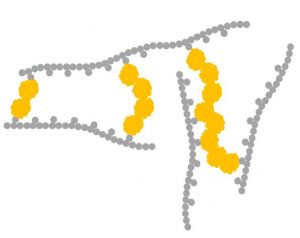Enhancing the stability of biomass-processing enzymes
We are investigating the basis of (thermo)stability in bacterial biomass-processing enzymes, and will use this information to engineer stability into enzymes of interest in the wood biorefinery.
Cross-linked protein-carbohydrate hydrogels

Using newly discovered carbohydrate-binding proteins, we are developing a novel method for hydrogel formation via biopolymer cross-linking.
Wood cell walls on the nano level
The aim of the project is to obtain information about the nanoscale distribution of the constituents in wood cell walls, such as cellulose, hemicellulose, and lignin. To reach our aim we will use a novel infrared microscopy technique (nano FTIR microscopy) with the unique ability to provide chemical information with a spatial resolution of 20 […]
Self-assembly of 2D nanoflakes by using 1D cellulose nanofibrils
The earth-abundant 1D cellulose nanofibrils (CNFs) have shown the capacity to assemble different functional nanoparticles into 2D films and 3D foams. 2D nanomaterials such as MXene, graphene, transitional metal dichalcogenides (MoS2, WS2, etc.) are the ones of most promising functional materials in optical, electronic, and magnetic fields. We are using the 1D CNF to align […]
Smuts, olje- och vattenavvisande träytor
Detta är ett Formasfinansierat projekt 2018-2022 som har en doktorand vid KTH i samarbete med RISE och nu med Karlstads universitet. Doktoranden Haiyan Yin licade i november 2020 och fortsätter till doktor. Hon har publicerat två arbeten hittills, ett i Materials and Design och ett i Holzforschung.
Renewable High-Performance Materials from the Forest with Designed Degradation – Next Generation of Plastic (Re-Design Plastic)
Sustainable material design can alleviate the environmental burden related to material waste. Use of available and abundant resources, create materials that can be recycled, and final degradability in nature is central to achieve this. The overarching aim of the proposal is to holistically design new materials from cellulose fibers by; developing new sustainable modification strategies, […]
H2O2 – Fuel and Energy Technology for the Future
Researching all-organic photo- and electro-catalysis to explore novel pathways to produce hydrogen peroxide, H2O2, and convert this fuel into electricity with a novel fuel cell technology. In order to achieve high-rate and large-volume production of H2O2 and conversion into electricity, we suggest to research and develop a novel catalytic paper electrode technology. These paper electrodes […]
Development of biobased and recyclable composite materials
We aim to develop new renewable and recyclable materials generated from bioderived sources. Our particular interest is directed towards development of composite materials based on nanofibrilated cellulose and epoxy thermosets.
Large-scale extrusion of protein superabsorbents with cellulose fibres for hygiene applications
The project focus on producing sustainable superabsorbents (SAP) by utilizing fully integrated natural-based and biodegradable raw materials, combined with highly scalable polymer processing techniques. Extrusion of proteins combined with cellulose fibres, as a hygroscopic carrier for a water in-situ foaming process, is going to be implemented. The addition of blowing agents and reagents are going […]
Functional materials derived from wood and CNF
Functional composite materials derived from wood or CNF and studying their structure property relationship for energy harvesting, sensing and other applications.
Material properties of wooden material: scale effect
The use of wood as a building material because of its efficiency, sustainability, and durability is increasing. Wood is a renewable resource, it has low carbon impact and low embodied energy. The amount of energy needed for producing wood products is much less than comparable products made from other materials. In spite of its common […]
Controlling product characteristics on board machine utilization process data
Quality on any board and paper products is dependent on being able to maintain low variability within product characteristics. A common problem is that these characteristics are measured cannot be measured online in the production, and is the time resolution will therefor be very low. The product characteristics will be dependent on the process characteristics, where […]

